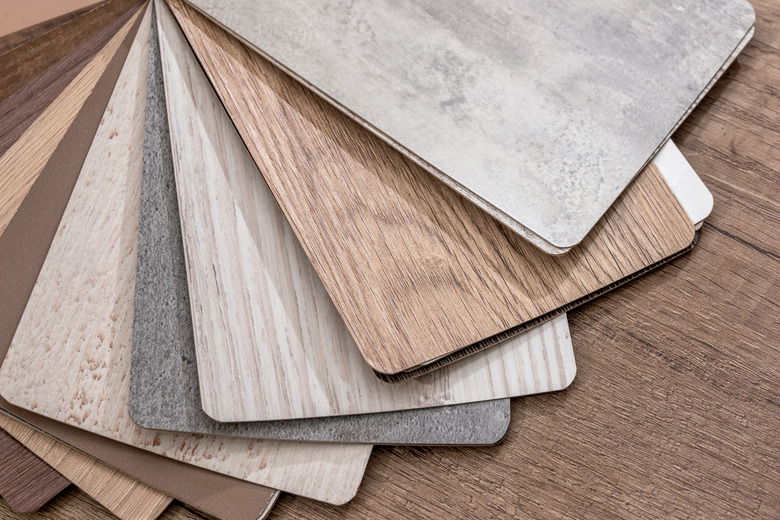Types Of Fake Wood Flooring
The beauty and durability of hardwood flooring is a selling point for many vintage homes. While installing hardwood flooring in a newer home or during remodeling may be out of reach for your budget, you can replicate the look with fake wood flooring. Your options range from laminate to vinyl to wood-look porcelain tile, all suited to a busy lifestyle.
Click-Together Laminate Flooring
Click-Together Laminate Flooring
Laminate flooring provides the look of a hardwood floor. These flooring materials, available in click-together planks, are easy to install over flat subfloors or a slab foundation. The thin planks are composed of layers starting from top to bottom, a clear coating, printed wood-look paper, high-density fiberboard, and a melamine backing. There is no real wood in laminate flooring.
Though laminate flooring is easily installed, it has some drawbacks. In general, it is not suitable for bathrooms, kitchens, or laundry rooms. Water must be wiped up immediately to avoid seeping between the planks and damaging the flooring. When a plank is damaged, it must be replaced, which may require removing and reinstalling several rows of planks.
Peel-and-Stick Vinyl
Peel-and-Stick Vinyl
When a quick solution is needed to cover a concrete slab or old flooring, peel-and-stick vinyl planks or tiles may be the answer. These vinyl products range from parquet patterns, making it easy to minimize the edges, to wood-look planks. Vinyl planks and tiles are water-resistant and will not expand or contract like laminate and engineered wood products.
Peel-and-stick vinyl products are easy to install. Clean the underlying material thoroughly and then peel off the backing and stick down the plank or tile. Use them in entryways, playrooms, kitchens, and other locations where you need an easy-care flooring solution.
Luxury Vinyl Planks
Luxury Vinyl Planks
Luxury vinyl planks are available in a wide range of wood-look patterns and textures, much like laminate flooring. Sturdy and water-resistant or waterproof, they are available as click-and-lock or glue-down planks. Luxury vinyl planks may also feature a cushioning underlayment, making them more comfortable if you spend hours on your feet in the kitchen or home office.
Sheet Vinyl Flooring
Sheet Vinyl Flooring
Busy homeowners who have children and pets might consider sheet vinyl flooring. Today's sheet vinyl isn't the avocado, brown, and harvest gold or bright green and blue patterns of the 1970s. Modern designs range from traditional to exotic hardwoods as well as stone, geometric, and classic checkerboard, complete with textured surfaces. Sheet vinyl is best for wet areas, such as bathrooms, kitchens, and basements. It only requires sweeping and mopping or a steam mop vacuum for quick and thorough cleaning.
While a dedicated do-it-yourselfer can install sheet vinyl, the heavy 12-foot-wide rolls, prep work, and adhesive application indicate that installation is usually best handled by professional installers. If you're replacing pre-1980s vinyl flooring and it's in good condition, consider installing the new flooring over the top of the old to encapsulate any potentially asbestos-containing products. Modern sheet vinyl does not contain asbestos; it's removing the old vinyl that could be an issue.
Porcelain Tile Flooring Materials
Porcelain Tile Flooring Materials
In addition to laminate and vinyl flooring products, glazed ceramic or porcelain tiles are an option. The tiles range in size from 6 to 10 inches wide, 24 to 48 inches long, and up to 24 x 24-inch square and feature natural wood colors and patterns on the glazed surface. Offset by one-third with a 1/8-inch sanded grout joint, these premium tiles are easy to clean, waterproof, and mold- and slip-resistant. Made from natural ingredients, they are ideal for allergy sufferers.
Engineered Wood Flooring
Engineered Wood Flooring
While technically not fake wood, types of faux wood flooring include engineered wood planks. The top layer of the plank is approximately 0.5 to 6mm of real wood bonded to an inner core of three to nine thin layers of various hardwood species. The grain in the layers faces different directions, so swelling and shrinkage due to moisture are minimized.
Depending on the thickness of the top layer of wood, most engineered wood flooring can be sanded several times during its lifetime, making it easy to repair scratches and refinish the floors. This flooring is available in a wide range of wood species, widths, colors, and finishes depending on the manufacturer and vendor.
